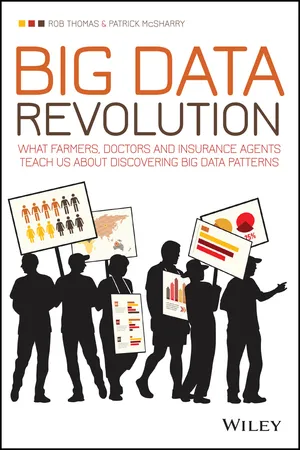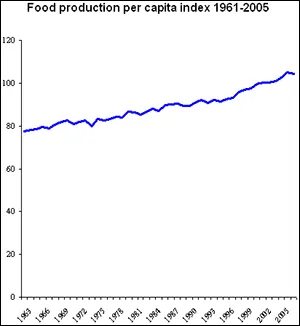
Big Data Revolution
What farmers, doctors and insurance agents teach us about discovering big data patterns
- English
- ePUB (mobile friendly)
- Available on iOS & Android
Big Data Revolution
What farmers, doctors and insurance agents teach us about discovering big data patterns
About this book
Big Data Revolution is a guide to improving performance, making better decisions, and transforming business through the effective use of Big Data. In this collaborative work by an IBM Vice President of Big Data Products and an Oxford Research Fellow, this book presents inside stories that demonstrate the power and potential of Big Data within the business realm. Readers are guided through tried-and-true methodologies for getting more out of data, and using it to the utmost advantage. This book describes the major trends emerging in the field, the pitfalls and triumphs being experienced, and the many considerations surrounding Big Data, all while guiding readers toward better decision making from the perspective of a data scientist.
Companies are generating data faster than ever before, and managing that data has become a major challenge. With the right strategy, Big Data can be a powerful tool for creating effective business solutions – but deep understanding is key when applying it to individual business needs. Big Data Revolution provides the insight executives need to incorporate Big Data into a better business strategy, improving outcomes with innovation and efficient use of technology.
- Examine the major emerging patterns in Big Data
- Consider the debate surrounding the ethical use of data
- Recognize patterns and improve personal and organizational performance
- Make more informed decisions with quantifiable results
In an information society, it is becoming increasingly important to make sense of data in an economically viable way. It can drive new revenue streams and give companies a competitive advantage, providing a way forward for businesses navigating an increasingly complex marketplace. Big Data Revolution provides expert insight on the tool that can revolutionize industries.
Frequently asked questions
- Essential is ideal for learners and professionals who enjoy exploring a wide range of subjects. Access the Essential Library with 800,000+ trusted titles and best-sellers across business, personal growth, and the humanities. Includes unlimited reading time and Standard Read Aloud voice.
- Complete: Perfect for advanced learners and researchers needing full, unrestricted access. Unlock 1.4M+ books across hundreds of subjects, including academic and specialized titles. The Complete Plan also includes advanced features like Premium Read Aloud and Research Assistant.
Please note we cannot support devices running on iOS 13 and Android 7 or earlier. Learn more about using the app.
Information
PART I: THE REVOLUTION STARTS NOW: 9 INDUSTRIES TRANSFORMING WITH DATA
CHAPTER 1: TRANSFORMING FARMS WITH DATA
CALIFORNIA, 2013
BRIEF HISTORY OF FARMING
- 1700s (Subsistence Farming): Farmers produced the minimum amount of food necessary to feed their families and have some in reserve for the cold winter months.
- 1800s (Farming for Profit): This era marked the transition from subsistence farming to for-profit farming. This is when the widespread use of barns began, for the purpose of storing tools, crops, and related equipment. These were called pioneer farms.
- Early 1900s (Power Farming): At this time, the “power” came in the form of 1,800-pound horses. The farmers used animals for plowing, planting, and transporting crops. The use of animal labor drove the first significant increase in crop productivity.
- Mid- to late 1900s (Machine Farming): Sparked by the Industrial Revolution, this era’s farmers relied on the automation of many of the tasks formerly done by hand or animal. The addition of machinery created tremendous gains in productivity and quality.

THE DATA ERA
POTATO FARMING
- Time: Data needs to be collected at regular intervals and decisions need to be made in near-real time.
- Geography: These tend to be large-scale operations (10,000 to 20,000 acres), with fields distributed over large areas.
- Man power: Data is often collected by farm field assistants (not scientists) and must be distributed because decision makers tend to be remote from the field.
- Irrigation: Irrigation, while very expensive, is a primary factor in the maturation of a potato crop. Utilizing data to optimize the use of irrigation can lead to a productive crop, at the lowest possible cost.
PRECISION FARMING
- Their growing strategy evolves each year.
- While the strategy evolves, their ability to execute improves each year, based on increased knowledge.
- Yield monitoring: Track crop yield by time or distance, as well as distance and bushels per load, number of loads, and fields.
- Yield mapping: Global Positioning System (GPS) receivers, along with yield monitors, provide spatial coordinates, which can be used to map entire fields.
- Variable-rate fertilizer: Managing the application of a variety of fertilizer materials.
- Weed mapping: Mapping weeds using a computer connected to a GPS receiver while adjusting the planting strategy, as needed.
- Variable spraying: Once you know weed locations from weed mapping, spot control can be practiced.
- Topography and boundaries: Creating highly accurate topographic maps using a Differential Global Positioning System (DGPS). This data can be used to take action on yield maps.
- Salinity mapping: This is valuable in interpreting yield maps and weed maps, as well as tracking the salinity over a period of time.
- Guidance systems: Guidance systems, such as DGPS (accurate to a foot or less) are valuable for assessing fields.
- Records and analyses: Large data collection is necessary to store pertinent data assets, along with images and geospatial information. It is important that this information can be archived and retrieved for future use.
CAPTURING FARM DATA

- Sensing equipment: Mounted devices on machinery, in fields, or anywhere near crops could be designed to collect/stream data or to control the application of water, pesticides, etc. This could range from instrumented tractors for harvesting to devices to monitor crop transpiration. The evolution of machines to collect data on crops and soil has been dramatic. In the last decade alone, equipment has evolved from mechanical-only to a combination of mechanical and digital technology. This change has been expedited by early insights that even small adjustments in planting depth or spacing can have huge impact on yields. So, while today the sensing equipment is largely a digitized version of common farm machines, the future will see a marked advancement in machines. Drones, driverless tractors, and other innovations will become commonplace.
- Global Positioning System (GPS): GPS provides the ability to pinpoint location accuracy within one meter. While GPS first emerged for automobiles in the early 1990s in places like Japan, it has just now become common in all automobiles. Farming equipment, as you may expect, has been even a step further behind, with the wide use of GPS just accelerating in the last decade.
- Geographic Information System (GIS): GIS assesses changes in the environment, tracks the spread of disease, as well as understanding where soil is moist, eroded, or has experienced similar c...
Table of contents
- Cover
- Title Page
- Table of Contents
- Prologue
- Introduction
- Part I: The Revolution Starts Now: 9 Industries Transforming with Data
- Part II: Learning from Patterns in Big Data
- Part III: Leading the Revolution
- Epilogue
- End User License Agreement